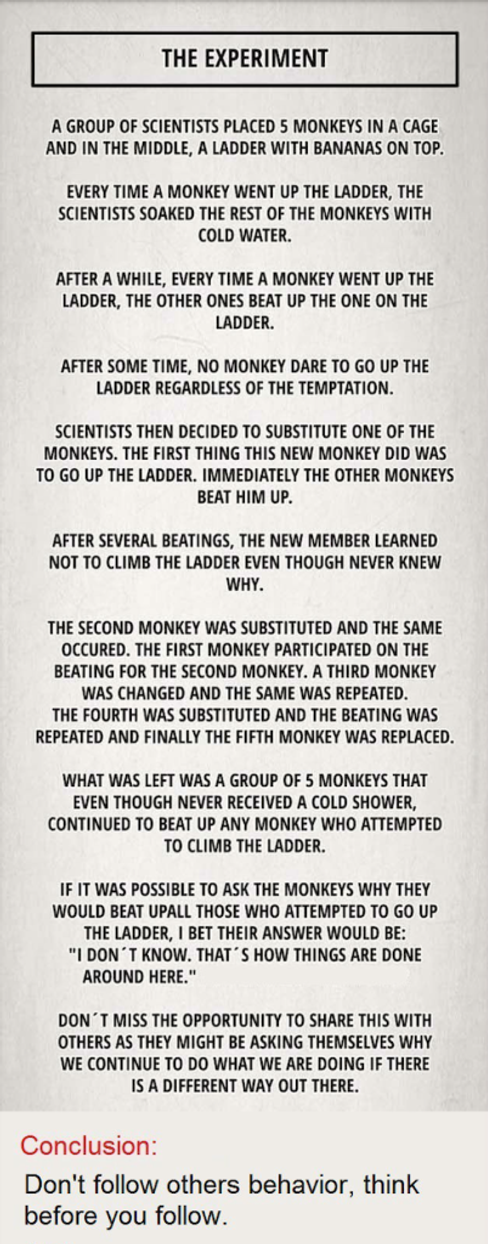IDDSI, monkeys and myths
- Sandra Robinson
- Jul 4, 2021
- 3 min read
Updated: Jun 1, 2023
A myth-busting blog!
Have you ever been asked to do something at work but not given a reason?
Or have been doing something for years thinking you know why but it turns out to be wrong?
Or you’re asked to do something, you then ask Why? and you’re told, "because that’s the way we do it around here".
On that last one, there’s a story that often does the rounds on social media and I’ve even heard it in mandatory training sessions. There are a few versions but it usually goes something like this;

Apart from the awful animal abuse involved, this sounds like a common sense and reasonable result of an experiment to highlight something about psychology, behaviour, mimetic actions etc. of people at work.
Except, it never happened. Complete and utter Bullmyth.
Which I’m pleased about. Let’s leave monkeys alone.

Fortunately this monkey was never experimented on
But it shows the power of a believable myth. (The other myth is the Mehrabian myth that only up to 7% of words contribute towards our understanding of communication. Again, utter Bullmyth. This time a result of misunderstanding statistics in a perfectly good study. Don’t get me started…)
So that’s the monkeys and a couple of myths. What about IDDSI? Are there myths around that?
YES.
And some speech therapists (including me in the past) have perpetuated myths in training. We all need to unlearn things. That’s actually learning. We make mistakes. We make errors. We learn something new. We change our mind. We change our practice. We share with others.
It’s why I like science. Popper’s ‘falsifiability’ is perfectly valid in dysphagia research. We should do more of it, frankly.
Crack on Sandra, what do we believe about IDDSI that’s not true?
Well, let’s say the jury is out on the evidence.
The literature talks about ‘texture modified diets’ (TMD). This is now standardised using the IDDSI Framework. What TMD looks like in your country may have changed in its terminology and appearance but that doesn’t make much difference to the evidence for TMD’s use in dysphagia management over the years.
So here’s the TMD (or IDDSI) myths;
Texture modified diets prevent aspiration (and its complications)
Texture modified diets prevent aspiration pneumonia (and its complications)
Bullmyths!
“Overall, there is no convincing evidence to suggest that texture modified foods […] benefit adults with dysphagia by preventing pneumonia and its consequences” O’Keefe, 20181
WHAT???!!! But it’s all over social media and mandatory training modules! Sandra, that can’t be right? As one famous publication puts it, shurely shome mishtake?!
Nope.
There is no evidence that IDDSIfying food prevents aspiration or prevents aspiration pneumonia. (And the outcomes of aspiration is another set of blogs altogether).
So why does TMD and IDDSI exist? What are speech therapists up to getting these poor patients to eat it, families and chefs struggling to make it, and massive changes all over the world to implement a new framework. What a scandal!
Let me reassure you. There are very good, evidence-based reasons for TMD and IDDSI. But aspiration isn’t one of them.
Before you learn how to make IDDSIfied meals, you need to know why.
Sign up to Sandra's dysphagia training to find out more!
O’Keeffe, S.T., 2018. Use of modified diets to prevent aspiration in oropharyngeal dysphagia: is current practice justified? BMC Geriatr 18, 167. https://doi.org/10.1186/s12877-018-0839-7



